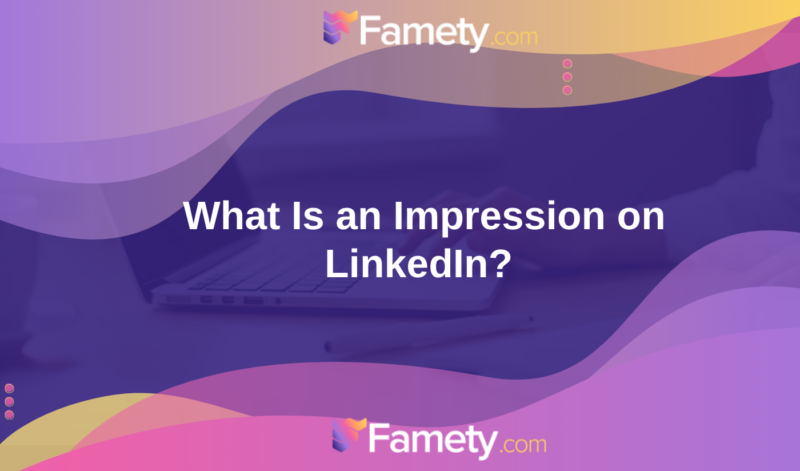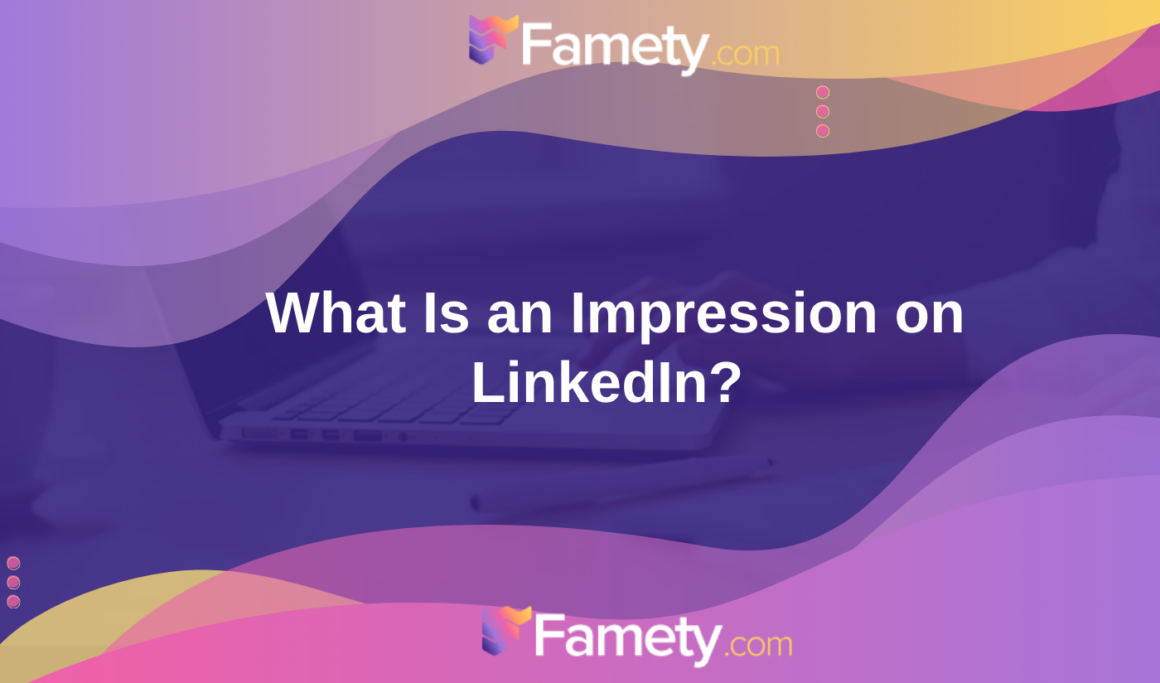
In the world of LinkedIn, impressions are a vital metric for understanding how your content is performing. They indicate how many times your post or ad has appeared on a user’s feed, providing insight into your visibility on the platform. For professionals, businesses, and content creators, impressions are more than just numbers—they are a reflection of reach and engagement potential.
While impressions alone don’t guarantee meaningful interaction, they are a crucial step in building visibility and encouraging deeper engagement, such as comments, shares, and LinkedIn likes. Tools like those offered by Famety (ex InstaFollowers), which allows users to purchase LinkedIn likes via Famety, can complement efforts to boost visibility and credibility on the platform. But to leverage impressions effectively, you first need to understand what they are and how they’re measured.
Understanding Impressions on LinkedIn
Impressions serve as a foundational metric for evaluating content performance on LinkedIn. By tracking impressions, users can assess how often their posts, articles, or ads are seen by others, providing insights into their overall visibility.
Definition of Impressions in the LinkedIn Context
An impression on LinkedIn refers to the number of times your content is displayed on a user’s feed.
- Unique Appearance: Each time your content appears on a user’s screen, it counts as one impression.
- Not Engagement-Based: Impressions are not tied to actions like clicks, shares, or LinkedIn likes, but they indicate how broadly your content is distributed.
- Broad Metric: They include both organic and paid content views, making them essential for evaluating the reach of your efforts.
Impressions are a key indicator of how effectively your content is reaching its intended audience.
How LinkedIn Tracks and Measures Impressions
LinkedIn uses an advanced algorithm to calculate impressions, ensuring accurate representation of your content’s reach.
- Counting Criteria:
- An impression is counted when your content is displayed on a user’s feed.
- It does not require interaction to be registered.
- Real-Time Tracking:
- LinkedIn provides metrics for impressions in real-time, allowing users to monitor their content’s performance immediately after posting.
- Distinguishing Content Types:
- LinkedIn measures impressions separately for posts, articles, and ads, offering tailored insights for each.
By understanding how impressions are tracked, users can better gauge their visibility and effectiveness on the platform.
Difference Between Impressions, Views, and Engagement
While impressions are essential for assessing visibility, they differ significantly from other LinkedIn metrics.

- Impressions vs. Views:
- Impressions count how often your content is displayed.
- Views, on the other hand, track how many people actively clicked on or opened your post or article.
- Impressions vs. Engagement:
- Engagement measures actions like likes, comments, and shares.
- Impressions are a prerequisite for engagement, as content must first be seen to inspire interaction.
- Strategic Importance:
- High impressions with low engagement may indicate that your content is visible but not resonating with your audience.
- Balancing impressions with tools like LinkedIn likes can amplify the impact of your content, encouraging more interaction.
Understanding the distinction between these metrics allows for a more nuanced approach to LinkedIn strategy, ensuring both reach and engagement are optimized.
Why Impressions Matter on LinkedIn
Impressions are a vital metric for measuring visibility on LinkedIn. They provide insights into how often your content appears on users’ feeds, setting the foundation for engagement metrics like comments, shares, and LinkedIn likes. For professionals and businesses, impressions serve as a key indicator of content reach and effectiveness.
The Role of Impressions in Building Visibility
Impressions are the first step in establishing your presence on LinkedIn. Without impressions, engagement is impossible.
- Expanding Your Reach:
- High impressions indicate that your content is being seen by a larger audience.
- They show how effectively your content cuts through LinkedIn’s crowded feed.
- Increasing Awareness:
- Regular appearances on users’ feeds build familiarity with your personal or business brand.
- Repeated impressions make your profile or company name more recognizable.
- Setting the Stage for Engagement:
- While impressions don’t directly measure interaction, they are essential for creating opportunities for likes, comments, and shares.
Focusing on increasing impressions ensures that your content is visible to the right audience, paving the way for meaningful interactions.
How Impressions Influence LinkedIn’s Algorithm
LinkedIn’s algorithm prioritizes content based on its potential to engage users, and impressions play a critical role in this process.
- Content Ranking:
- High impressions signal that your content is being distributed widely, increasing its chances of ranking higher in feeds.
- The algorithm promotes content with consistent visibility, ensuring it reaches more users.
- User Engagement Signals:
- The algorithm factors in user engagement like LinkedIn likes and comments.
- Content with high impressions and strong engagement is more likely to be shared with a broader audience.
- Relevance to Audience:
- LinkedIn tracks how users interact with your content after seeing it.
- High relevance increases the frequency of your content’s appearance in their feeds, boosting impressions further.
Understanding how impressions influence LinkedIn’s algorithm helps you craft content that gains traction and reaches more people.
Correlation Between Impressions and Content Reach
Impressions and reach are interconnected, and both are critical for building an effective LinkedIn strategy.

- Impressions Drive Reach:
- Each impression represents an opportunity to extend your content’s reach.
- High impressions increase the likelihood of users engaging with your posts or sharing them.
- Balanced Strategy:
- If impressions are high but engagement is low, it may indicate a need to refine your content or target audience.
- Tools like LinkedIn likes can help amplify engagement, creating a feedback loop that increases impressions further.
- Measuring Success:
- Monitoring impressions alongside engagement metrics provides a comprehensive view of content performance.
- High impressions combined with positive interactions signal that your LinkedIn strategy is effective.
Strategies to Increase LinkedIn Impressions
Boosting your impressions on LinkedIn requires a strategic approach that combines quality content, timely posting, and the effective use of platform tools. By increasing impressions, you can improve your content’s visibility and create opportunities for deeper engagement, such as likes, shares, and comments.
Content that resonates with your audience is more likely to generate impressions and foster engagement.
- Focus on Value:
- Share insights, tips, or resources that solve problems or address challenges your audience faces.
- Posts that are educational or inspirational tend to perform well on LinkedIn.
- Use Visuals:
- Incorporate images, videos, or infographics to make your content more visually appealing.
- Visual posts are more likely to stop users mid-scroll and boost impressions.
- Encourage Interaction:
- Pose questions, share polls, or invite feedback to spark conversations around your posts.
- Content that garners comments is favored by LinkedIn’s algorithm, increasing impressions.
- Highlight Achievements:
- Share milestones, awards, or success stories that celebrate professional growth.
- Such posts often resonate with your network and encourage engagement.
Creating content that is not only engaging but also shareable can significantly amplify your impressions and extend your reach.
Posting at Optimal Times for Your Audience
Timing plays a crucial role in ensuring your content appears on feeds when your audience is most active.
- Understand Your Audience’s Habits:
- Analyze when your connections or followers are most likely to be online.
- Consider factors like time zones and industry norms for activity peaks.
- Best Days to Post:
- Research shows that midweek (Tuesday through Thursday) often yields higher engagement on LinkedIn.
- Experiment with Times:
- Morning hours (7–9 AM) and lunchtime (12–2 PM) are generally effective for professional audiences.
- Monitor your post performance to identify the best time slots for your specific network.
- Consistency Matters:
- Regular posting at optimal times keeps your profile active and maintains consistent impressions.
Posting strategically ensures that your content reaches your audience when they’re most likely to see and engage with it.
Using hashtags and keywords effectively can expand your content’s visibility beyond your immediate network.
- Research Relevant Hashtags:
- Use industry-specific hashtags to target your audience.
- Combine popular hashtags with niche ones to balance reach and relevance.
- Include Keywords in Your Posts:
- Incorporate relevant keywords in your post copy to align with search queries and algorithm preferences.
- Limit Hashtags for Clarity:
-
- Use 3–5 hashtags per post to avoid clutter while still enhancing discoverability.
-
- Engage with Hashtags:
- Follow and engage with trending hashtags in your industry.
- Commenting on posts within these hashtags can also drive traffic back to your profile.
Strategically using hashtags and keywords increases the chances of your content being discovered by a broader audience, driving higher impressions.
Final Thoughts on LinkedIn Impressions
LinkedIn impressions are more than just numbers; they are a critical metric for measuring your visibility and reach on the platform. By understanding and optimizing your impressions, you can enhance your professional presence, expand your network, and drive meaningful engagement. Let’s summarize the importance of impressions and how to use them effectively in your LinkedIn strategy.
Understanding the Importance of Impressions in Networking
Impressions serve as the foundation for creating meaningful connections and expanding your professional reach.
- First Step in Engagement:
- Impressions indicate how often your content is seen, providing the initial touchpoint for interaction.
- Without impressions, opportunities for likes, comments, or shares would not exist.
- Increased Visibility:
- High impressions mean your content is reaching a broader audience, helping you stand out in a crowded professional network.
- Building Awareness:
- Regular appearances on users’ feeds enhance brand recall, making your profile or company more recognizable.
Understanding the role of impressions in networking ensures you’re leveraging them to create opportunities for deeper connections and professional growth.
Combining Impressions Metrics with Other Performance Indicators
While impressions are essential, they are most effective when analyzed alongside other LinkedIn performance metrics.
- Engagement Metrics:
- Pair impressions with metrics like LinkedIn likes, comments, and shares to gauge how well your content resonates with your audience.
- A high impression count with low engagement might indicate a need to refine your content strategy.
- Profile Visits:
- Monitor profile views alongside impressions to assess how effectively your content drives traffic to your profile.
- Conversion Rates:
- For businesses, measure how impressions translate into tangible outcomes, such as leads, job offers, or connections.
Analyzing impressions in conjunction with other metrics provides a more comprehensive view of your LinkedIn performance, allowing for targeted improvements.
Building a Long-Term Strategy for Sustainable Growth
To maximize the benefits of impressions, it’s essential to integrate them into a broader, sustainable LinkedIn strategy.
- Content Consistency:
- Regularly post high-quality, engaging content to maintain a steady flow of impressions.
- Audience Engagement:
- Actively engage with your audience to foster relationships and encourage reciprocal interactions.
- Experimentation and Adaptation:
- Test different content formats, posting times, and hashtags to identify what works best for your audience.
- Adjust your strategy based on performance metrics, including impressions and engagement.
- Incorporating Tools:
- Utilize tools like LinkedIn likes from services like Famety to amplify your content’s reach and boost its impact.
Building a sustainable strategy ensures that your LinkedIn activity remains effective in the long term, driving both impressions and meaningful engagement.

